 W
WThe Huayquerías Formation is a Late Miocene fossiliferous geological formation of the Frontal Cordillera and Cuyo Basin of Argentina. The formation crops out in the central Mendoza Province.
 W
WAcrophoca longirostris, sometimes called the swan-necked seal, is an extinct genus of Late Miocene pinniped. It was thought to have been the ancestor of the modern leopard seal, however it is now thought to be a species of monk seal.
 W
WAdinotherium is an extinct genus of Toxodontidae, large bodied hoofed ungulates which inhabited South America during the Middle to Late Miocene, from 17.5—6.8 Ma and existed for approximately 10.7 million years , Santacrucian to Huayquerian in the South American land mammal ages (SALMA). Fossils of Adinotherium have been found in the Santa Cruz and Ituzaingó Formations of Argentina and the Chucal and Río Frías Formations of Chile.
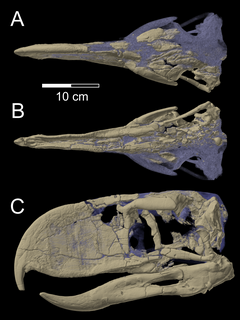 W
WAndalgalornis is a genus of flightless predatory birds of the extinct family Phorusrhacidae that lived in Argentina. The type and only species is A. steulleti.
 W
WArgentavis magnificens was among the largest flying birds ever to exist, quite possibly surpassed in wingspan only by Pelagornis sandersi, which was described in 2014. A. magnificens, sometimes called the Giant Teratorn, is an extinct species known from three sites in the Epecuén and Andalhualá Formations in central and northwestern Argentina dating to the Late Miocene (Huayquerian), where a good sample of fossils has been obtained.
 W
WAulophyseter is an extinct genus of sperm whales from the Miocene formations of the west and east coasts of North America, as well as the Patagonian region of South America.
 W
WCarcharodon hubbelli, also known as Hubbell's white shark, is an extinct species of white shark that evolved between 8 to 5 million years ago during the Late Miocene to Early Pliocene epochs. The shark is a transitional species, showing intermediate features between present-day great white sharks and smaller, prehistoric mako sharks. Its fossils have been unearthed in Peru.
 W
WThe Cerro Azul Formation, in the Buenos Aires Province also described as Epecuén Formation, is a geological formation of Late Miocene age in the Colorado Basin of the Buenos Aires and La Pampa Provinces in northeastern Argentina.
 W
WDiadiaphorus is an extinct genus of litoptern mammal from the Miocene of Argentina and Bolivia, South America.
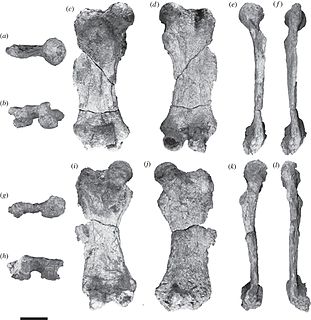 W
WEionaletherium is an extinct genus of ground sloth from the Late Miocene coasts of Venezuela containing one species: E. tanycnemius.
 W
WEleutherocercus was a genus of glyptodonts that lived during the Late Miocene and Early Pliocene in South America. Fossils of the genus have been found in the Huayquerian Ituzaingó Formation and the Montehermosan Monte Hermoso Formation in Argentina.
 W
WGryposuchus is an extinct genus of gavialoid crocodilian. It is the type genus of the subfamily Gryposuchinae. Fossils have been found from Argentina, Colombia, Venezuela, Brazil and the Peruvian Amazon. The genus existed during the Miocene epoch. One recently described species, G. croizati, grew to an estimated length of 10 metres (33 ft).
 W
WHapalops is an extinct genus of ground sloth from the Early to Late Miocene of Brazil, Bolivia, Colombia, and Argentina in South America.
 W
WHoffstetterius is an extinct genus of toxodontid notoungulate mammal, whose remains were discovered in the Middle to Late Miocene Mauri Formation in the La Paz Department in Bolivia. The only described species is the type Hoffstetterius imperator.
 W
WIncakujira is an extinct genus of rorqual from the Late Miocene Pisco Formation in western Peru.
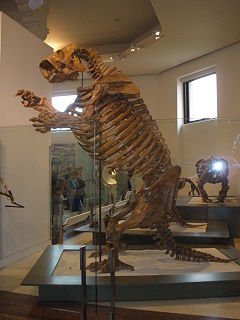 W
WLestodon is an extinct genus of megafaunal ground sloth from South America during the Pliocene to Pleistocene periods. Its fossil remains have been found in Argentina, Paraguay, Uruguay, Venezuela, Bolivia, and Brazil. Measuring approximately 4.6 metres (15 ft) from snout to tail tip, it is estimated to have weighed 2,590 kilograms. It was a herbivore and primarily fed on the grasses on the South American plains and is thought to perhaps have used its semi-bipedal stance to obtain foliage from trees. Lestodon is placed as member of the Mylodontidae as indicated by the lobed form of the last tooth in the dentition.
 W
WMacrauchenia was a large, long-necked and long-limbed, three-toed native South American mammal in the order Litopterna. The genus gives its name to its family, the Macraucheniidae or "robust litopterns". Like other litopterns, it is not closely related to any living mammal, being most closely related to the group containing horses, rhinos and tapirs, from which litopterns diverged approximately 66 million years ago. The oldest fossils in the genus date to the late Miocene, around seven million years ago, and M. patachonica disappears from the fossil record during the late Pleistocene, around 20,000-10,000 years ago. M. patachonica is one of the last and best known member of the family and is known primarily from the Luján Formation in Argentina, but is known from localities across southern South America. Another genus of macraucheniid Xenorhinotherium was present in northeast Brazil and Venezuela during the Late Pleistocene. The type specimen was discovered by Charles Darwin during the voyage of the Beagle. In life, Macrauchenia may have resembled a humpless camel, though the two taxa are not closely related. It fed on plants in a variety of environments across what is now South America. Among the species described, M. patachonica and M. ullomensis are considered valid; M. boliviensis is considered a nomen dubium; and M. antiqua has been moved to the genus Promacrauchenia.
 W
WMacroeuphractus is a genus of extinct armadillos from the Late Miocene to Late Pliocene of South America. The genus is noted for its large size, with Macroeuphractus outesi being the largest non-pampathere or glyptodont armadillo discovered, as well as its specializations for carnivory, unique among all xenarthrans.
 W
WMourasuchus is an extinct genus of giant, aberrant caiman from the Miocene of South America. Its skull has been described as duck like, being broad, flat and very elongate, closely resembling what is seen in Stomatosuchus, an unrelated crocodylian that may also have had a large gular sac similar to those of pelicans or baleen whales. Mourasuchus, is a strange nettosuchid with an unusually long, broad snout.
 W
WPelagornis is a widespread genus of prehistoric pseudotooth birds. These were probably rather close relatives of either pelicans and storks, or of waterfowl, and are here placed in the order Odontopterygiformes to account for this uncertainty.
 W
WThe Pisco Formation is a geologic formation located in Peru, on the southern coastal desert of Ica and Arequipa. The approximately 640 metres (2,100 ft) thick formation was deposited in the Pisco Basin, spanning an age from the Middle Miocene up to the Early Pleistocene, roughly from 15 to 2 Ma. The tuffaceous sandstones, diatomaceous siltstones, conglomerates and dolomites were deposited in a lagoonal to near-shore environment, in bays similar to other Pacific South American formations as the Bahía Inglesa and Coquimbo Formations of Chile.
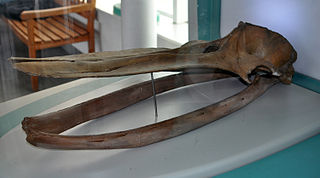 W
WPiscobalaena is an extinct genus of cetaceans, which lived from the Middle to Late Miocene epochs in Peru and Florida. Its fossils have been found in the Pisco Formation of Peru and the Bone Valley Formation of Florida. At least some individuals of this diminutive whale were preyed on by the shark C. megalodon.
 W
WPiscogavialis is an extinct genus of gryposuchine gavialid crocodylian. The only species yet known is P. jugaliperforatus. Fossils of Piscogavialis have been found from the Mio-Pliocene Pisco Formation of the Sacaco Basin in southern Peru in 1998. It is the first reptile known from the formation, which is otherwise notable for its high diversity of fossil vertebrates.
 W
WProcariama is an extinct monotypic genus of giant flightless predatory birds, reaching about 70 centimetres (2.3 ft) in height and 10 kilograms (22 lb) in body mass, in the family Phorusrhacidae or "terror birds" which lived in Argentina. Fossils have been found in the Cerro Azul and Andalhuala Formations.
 W
WPromegatherium is a genus of prehistoric xenarthrans that lived in Argentina, during the Late Miocene. This genus is regarded as closely related to the later, and more famous genus, Megatherium, hence the reference in the name. The first specimens of Promegatherium were originally described by the biologist Florentino Ameghino in 1887. Its known species are Promegatherium cabreri, P. nanum, P. parvulum, P. remulsum, and P. smaltatus. P. nanum was originally placed in the genus "Eomegatherium" before it was grouped together in Promegatherium.
 W
WPronothrotherium is an extinct genus of ground sloths from South America. Fossils of Pronothrotherium have been found in the Ituzaingó Formation of Argentina.
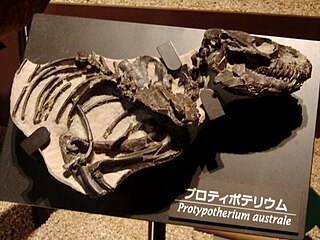 W
WProtypotherium is an extinct genus of notoungulate mammals native to South America during the Miocene epoch. A number of closely related animals date back further, to the Paleocene. Fossils of Protypotherium have been found in the Deseadan Fray Bentos Formation of Uruguay, Muyu Huasi Formation of Bolivia, Cura-Mallín and Río Frías Formations of Chile, and Santa Cruz, Salicas, Ituzaingó, Cerro Bandera, Chichinales, Sarmiento and Collón Curá Formations of Argentina.
 W
WPsilopterus is an extinct genus of phorusrhacid from the Middle Oligocene to Late Pleistocene of Argentina and Uruguay. Compared to other phorusrhacids, members of the genus are both relatively gracile and diminutive, and include the smallest known species of terror bird: with the head raised P. bachmanni was 70–80 centimeters (2.3–2.6 ft) in height and weighed about 5 kilograms (11 lb), while the largest members of the genus were only about 7 kilograms (15 lb). The birds resemble the modern cariama, except with a heavier build and considerably smaller wings. The strong morphological similarity between the claws of the predatory cariama and Psilopterus, both of which are sharp, curved, and laterally compressed, may indicate they were used to strike prey. In contrast to the other, larger terror birds, Tonni and Tambussi also suggested Psilopterus could use their claws to climb trees, and could even fly, but this has been rejected in more recent literature. Fossil finds in Uruguay indicate the genus may have survived until 96,040 ± 6,300 years ago, millions of years after the larger phorusrhacids became extinct.
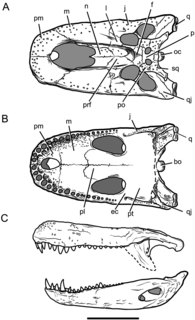 W
WPurussaurus is an extinct genus of giant caiman that lived in South America during the Miocene epoch, from the Colhuehuapian to the Montehermosan in the SALMA classification. It is known from skull material found in the Brazilian and Peruvian Amazon, Colombian Villavieja Formation, Panamanian Culebra Formation and the Urumaco and Socorro Formations of northern Venezuela.
 W
WThe family Caenolestidae contains the seven surviving species of shrew opossum: small, shrew-like marsupials that are confined to the Andes mountains of South America. The order is thought to have diverged from the ancestral marsupial line very early. They were once included in the superorder but it is now known that Ameridelphia is paraphyletic, having given rise to Australidelphia, and thus could be considered an evolutionary grade. Genetic studies indicate that they are the second most basal order of marsupials, after the didelphimorphs. As recently as 20 million years ago, at least seven genera were in South America. Today, just three genera remain. They live in inaccessible forest and grassland regions of the High Andes.
 W
WStupendemys is a prehistoric genus of freshwater side-necked turtle. Its fossils have been found in northern South America, in rocks dating from the Middle Miocene to the very start of the Pliocene, about 13 to 5 million years ago.
 W
WThalassocnus is an extinct genus of semiaquatic ground sloths from the Miocene and Pliocene of the Pacific South American coast. It is monotypic within the subfamily Thalassocninae. The five species—T. antiquus, T. natans, T. littoralis, T. carolomartini, and T. yuacensis—represent a chronospecies, a population gradually adapting to marine life in one direct lineage. They are the only known aquatic sloths. They have been found in the Pisco Formation of Peru and the Bahía Inglesa, Coquimbo, and Horcón formations of Chile. Thalassocninae has been placed in both the families Megatheriidae and Nothrotheriidae.
 W
WThylacosmilus is an extinct genus of saber-toothed metatherian mammals that inhabited South America from the Late Miocene to Pliocene epochs. Though Thylacosmilus looks similar to the "saber-toothed cats", it was not a felid, like the well-known North American Smilodon, but a sparassodont, a group closely related to marsupials, and only superficially resembled other saber-toothed mammals due to convergent evolution. A 2005 study found that the bite forces of Thylacosmilus and Smilodon were low, which indicates the killing-techniques of saber-toothed animals differed from those of extant species. Remains of Thylacosmilus have been found primarily in Catamarca, Entre Ríos, and La Pampa Provinces in northern Argentina.
 W
WThylamys is a genus of opossums in the family Didelphidae. The premaxillae are rounded rather than pointed. The females lack a pouch. The females' nipples are arranged in two symmetrical rows on the abdomen. All species but T. macrurus store fat in their tails., although this is not necessarily true for all species in the genus. Fossils belonging to the genus date back to the Miocene, with the oldest specimens being found in the Cerro Azul Formation of Argentina and the Honda Group of Colombia. Genetic studies indicate that the genus may have originated around 14 million years ago.
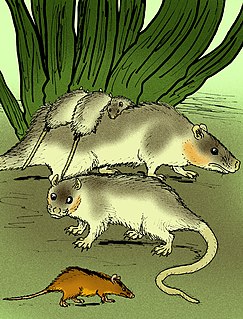 W
WThylophorops is an extinct genus of didelphine opossums from the Pliocene of South America. Compared to their close didelphine cousins like the living Philander and Didelphis opossums, Thylophorops displays specialization towards carnivory, and one species, T. lorenzinii, is the largest known opossum of all time, which could imply a macropredatory role.
 W
WToxodon is an extinct genus of South American mammals from the Late Miocene to early Holocene epochs. It is a member of Notoungulata, one of several now extinct orders of hoofed mammals indigenous to South America. It was among the largest and last members of its order, and was probably the most common large hoofed mammal in South America of its time.
 W
WTrigodon is an extinct genus of the family Toxodontidae, a large bodied notoungulate which inhabited South America during the Late Miocene to Early Pliocene, living from 11.61—4.0 Ma and existed for approximately 7.61 million years . The type species is T. gaudryi.
 W
WXenastrapotherium is an extinct genus of astrapothere, a type of hoofed herbivorous mammal, native to South America, which lived in the Middle to Late Miocene period, typically during the Laventan stage. It is a member of the family Astrapotheriidae in the subfamily Uruguaytheriinae, large astrapotheres, equipped with a trunk-like nose and protruding teeth, similar to the elephants, but their tusks were the canine teeth, not the incisors. Xenastrapotherium was a genus widely distributed in northern South America, in contrast to other species of astrapotheres which lived in the area of the Southern Cone of the continent. It differed from other astrapotheres by having two lower incisors on each side of the jaw and the tusks have a pronounced longitudinal curvature, although their general shape and size are probably very similar to Astrapotherium, whose weight would be 900 to 1,500 kilograms, comparable to the current black rhino.
 W
WXotodon is an extinct genus of toxodontid mammal that lived during the Late Miocene in Argentina, South America. Fossils of Xotodon have been found in the Ituzaingó, Maimará and Chiquimil Formations of Argentina.